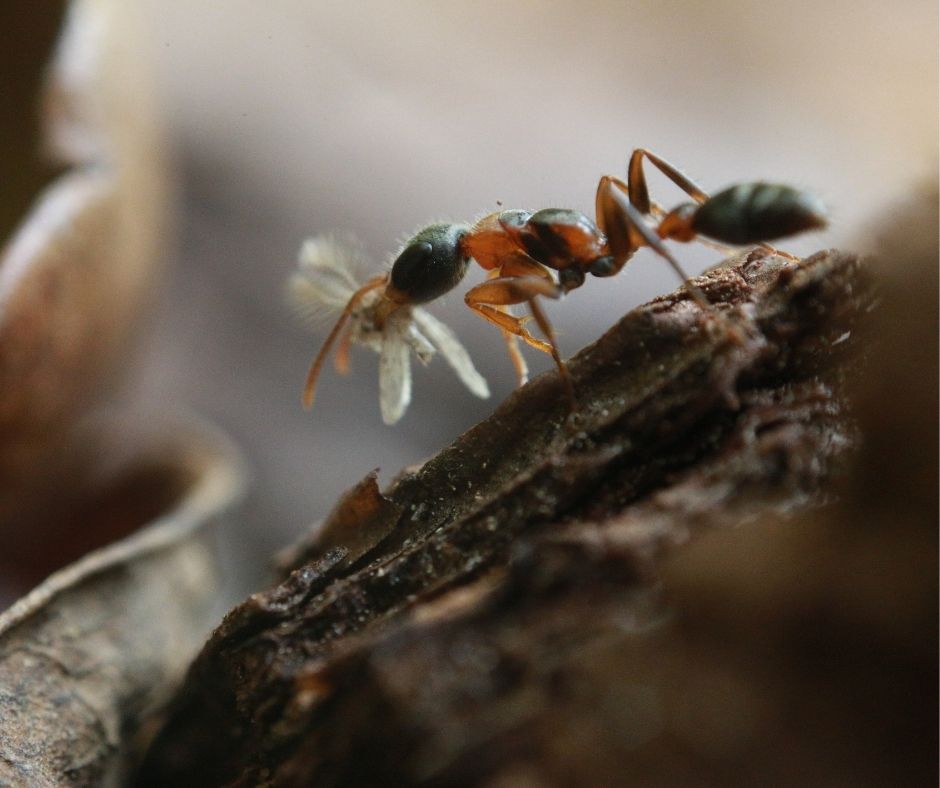
More Pest ID
- Acrobat Ants
- American Cockroach
- American Dog Tick
- Argentine Ants
- Asian Roach
- Bed Bugs
- Big Headed Ant
- Black Legged Tick
- Black Widow Spider
- Brown Banded Roach
- Brown Dog Tick
- Brown Widow Spider
- Cellar Spider
- Crazy Ant
- Dry Wood Termites
- Fire Ants
- Florida Carpenter Ants
- Florida Woods Roach
- Formosan Termites
- German Roach
- Ghost Ants
- Jumping Spider
- Little Yellow Ant
- Lone Star Tick
- Oriental Roach
- Pavement Ants
- Pharaoh Ants
- Pyramid Ants
- Rover Ant
- Smokybrown Roach
- Subterranean Termites
- Thief Ant
- White-Footed Ant
- Wolf Spider
- Yellow Sac Spider
About the Elongated Twig Ant
The Elongated twig ant is a stunning tree-dwelling species that can best be identified by its unique black and orange coloring. And at first glance, a person may think they’ve stumbled upon a tiny wasp. Immediately, they assume this species to be aggressive and dangerous.
However, the Elongated twig ant is relatively tame and rarely harms humans.
Learn more about this fascinating ant species by reading through this informational Pest ID page provided by the Drive Bye Exterminators.
Appearance
The Elongated Twig ant can be identified by its bi-color and slender appearance. This ant species is a little larger than a quarter of an inch. Many relate its appearance to a wasp due to its coloring and slim shape.
The following can be used to identify the Elongated Twig ant correctly:
- Large, oval-shaped eyes
- Dull orange and black coloration
- Scattered hair-like projections
- The stinger at the end of its abdomen
- Two antennae
- Wings on some members of the colony
Behavior
The colony of the Elongated Twig ant includes one queen ant and several other members. They are considered arboreal, which means they typically dwell in trees. However, they also nest in dry grass, shrubs, hollow branches, and twigs.
If you happen to encounter this unique ant species, you will only see one in most cases. They are solitary hunters and are not often spotted in large gatherings or massive colonies.
Some consider the Elongated twig ant a pest due to its tendency to sting or bite when threatened or disturbed. For example, if this ant species falls from its nest and lands inside your clothes, it will likely sting in desperation to find its way out.
Candis Hawkinson, a member of the Galveston County Master Gardeners, describes the rarity and nature of an Elongated Twig ant attack:
“We have encountered numerous Elongate Twig Ants over the years while maintaining the Master Gardener Demonstration Garden adjacent to the Galveston County Extension Office. During that time, just one Master Gardener has received an Elongate Twig Ants sting. She was wearing shorts when she happened to sit on an Elongate Twig Ant! She reported the sting to be similar to that of an imported fire ant sting (she still works in the Demonstration Garden but now looks down before sitting!).”
However, they aren’t usually an issue indoors. Elongated Twig ants become a significant issue when they’ve made a home in an area where children play outdoors.
Diet
This ant species feeds on live insects like butterflies, moths, and aphids. It also consumes the honeydew produced by aphids and fungus spores.
Habitat
Elongated Twig ants were first discovered in Mexico and have spread into the southern United States. Here, they are sparse in population, but you may spot them occasionally.
Their range spans from Argentina to Texas, with Caribbean, Hawaii, and Florida populations. The Elongated Twig ant prefers warmer climates with plenty of trees and shrubs to nest.
Have You Spotted Elongated Twig Ants in Your Home or Yard?
If you have found this special ant species in your yard, think twice before panicking. The Elongated twig ant can benefit home gardens by consuming plant-destroying pests. And in most cases, they go unnoticed and cause no trouble for humans.
However, if you or a household member are sensitive to insect bites and stings, you may want to consider calling a pest control company, like the trusted experts at Drive Bye.
Additionally, if the ants have nested in an area where your children or pets like to play, it may be best to remove the insect to avoid attacks.
On the other hand, if they are found in your home, you’ll certainly want to reach out to the professionals. Like with most home invaders, regardless of their behaviors, they aren’t welcomed. In fact, even though this ant species isn’t known to cause significant problems in the home, it can attract other problematic pests.
Preventing an Infestation of Elongated Twig Ants:
- After spending time outdoors, check for Elongated twig ants on your body and clothing. The number one way they make their way indoors is by accidentally catching a ride on humans.
- After use, wipe down countertops, dining tables, sinks, and other food areas. Reducing mess inside the home always helps to prevent pests of any kind.
- Keep food enclosed in containers.
- Place pet food high and off the floor.
- Seal cracks and damages to the outside of the home.
- Keep grass and bushes trimmed to prevent overgrowth that makes for the perfect Elongated twig ant habitat.
How to Get Rid of Elongated Twig Ants with Drive Bye
Indoors or outside, if you have found unwelcomed Elongated Twig ants on your property, give the Drive Bye Exterminators a call.
Drive Bye Exterminators has the answer for pest control in your home. Ants are eradicated with our years of experience and quality products.
If you see these ants, or any ants for that matter, call your local pest control company before the infestation gets any worse.






